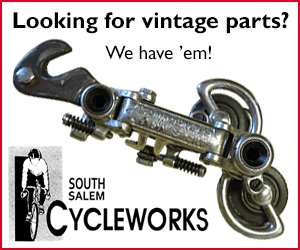

Fixing Pro Cycling
By Larry Theobald

Les Woodland's book Sticky Buns Across America: Back-roads biking from sea to shining sea is available in print, Kindle eBook & audiobook versions. To get your copy, just click on the Amazon link on the right.
Larry Theobald, a long-time friend and formerly of CycleItalia still keeps his interesting blog updated. Click here to check it out.
Here, he give his thoughts about repairing professional cycling.
It seems every month I read about a new plan to “save” pro cycling. “Cycling’s business model is dead” claim the writers, and when team sponsors increasingly seem to be limited to authoritarian regimes, resource extraction operations, gambling interests and the bike industry, with a few passionate plutocrats or a grocery store chain making up the rest, one can be forgiven for thinking something might actually BE wrong. Some teams struggle along with budgets of “merely” 15 million Euros while others exceed 50 million. You don’t need to be a genius to figure out which teams have more success.
Hasn’t it always been this way to some degree? At least since Henri Desgrange’s Tour de France national team model was scrapped, the richer backers could always attract Coppi, Bartali, Merckx, Maertens, Saronni, Moser, LeMond, Hinault, Indurain, etc. and build a support team around them.

Tour father Henri Desgrange in 1931 with 1930 & 1932 Tour winner André Leducq, who rode for Team France
I started following the sport in earnest in the early 1980s with the success of Greg LeMond and don’t remember a lot of whining and gnashing of teeth over this, even when characters like Bernard Tapie started throwing money around the sport. And let’s not forget that despite a poorly funded team, that same LeMond won LeTour 1989 post-Tapie as part of the ADR squad. Since there were no automatic guaranteed Tour entries back then one assumes the only reason LeMond’s team was invited into Le Grand Boucle was because 1986 winner was part of the team. Where’s the problem?

Greg LeMond time trialing in the 1989 Tour de France. Sirotti photo
Before the World Tour’s debut in 2005 teams came and went, including teams from the USA like 7-Eleven who gained entry into the Giro d’Italia in 1985 and LeTour in 1986. I remember team manager Jim Ochowicz joking in 1988 that for $30K his team gained entry into the big show, received housing and meals for team and staff, two Peugeot-branded team cars and a couple of towels! There were no team buses (the Sauna Diana bus supplied to TVM came along in 1989), no in-team chefs, box-trucks full of bikes, parts and laundry machines. Rider’s kits were laundered by hand in the hotel sink and hung out to dry in the window. LeMond’s “million dollar” contract was for three years, not much in the big-time sports world when compared to North American franchise sports or European football. But again, I remember few complaints, especially from the part of the world where cycling was popular, mainly western Europe.
Greg LeMond’s dramatic win in 1989 inspired some multinational companies to enter the world of pro cycling, but as race sponsors rather than through teams. Coca-Cola, Nestle and others saw some potential in marketing to fans drawn to the sport through LeMond’s success (he was even on the famous “Wheaties” cereal box). You might say the Anglophone world woke up to cycling and its advertising potential.
Fast-forward to 1991 when a multi-national candy company executive took over the helm of the International Cycling Union, before this was a mostly sleepy sanctioning body. Can you even remember who was UCI president before Hein Verbruggen? You might remember Verbruggen, he was the guy who later claimed: “Lance Armstrong has never used doping. Never, never, never.” This Dutchman had big ideas, in 2005 introducing the Pro (later World) Tour of cycling, a Formula One style licensing scheme limited to 20 teams who would pay for the privilege (and be obligated to participate) in all the big races. Race organizers saw this as a power grab but eventually signed-on to the scheme with its promises of improving pro cycling’s financial situation as well as reducing doping scandals.
They caved in, but nobody except Verbruggen (and the next UCI president Pat McQuaid) seemed very happy with this new arrangement. Most felt the UCI was shoving it down their throats. One team boss said a few years after its debut: “I'm more than fed up with all the arguing. ASO and UCI don't know how much damage they are doing to the sport. What am I supposed to tell my sponsors? This conflict has been going on for three years and is escalating all the time. Can the teams be certain that they will be able to take part in the Tour de France later in the year?” In 2022 the arguments are about teams being relegated, all while “cycling’s business model” continues to be broken according to some.
The World Tour has staggered along since 2005, a few times seeing 17 teams fighting over (reduced perhaps by lack of interest?) 18 places while race organizers still fume over being forced to take teams of skinny climbers at Paris-Roubaix while non-WT teams of burly cobble specialists are left out. WT requirements greatly inflated team rosters to ensure teams would be able to field riders at obligatory events as well as those of their own special interest. Back in the days of Moser-Saronni, teams had barely a dozen riders and a budget that wouldn’t even field an amateur team today. Small companies like salami producers, furniture factories and ice cream makers could easily afford to bankroll competitive teams, something that seems impossible these days.
But there must be benefits of the WT, right? One of them might be buying your way into the top club by scooping up a license given up by a team going bust, though that going bust part was something the WT was supposed to reduce or eliminate. Other promises included the globalization of the sport with hints about piles of money coming from the likes of China to bankroll major new races. At one point it was said a Chinese conglomerate would take over the Tour de France organizer ASO or start a rival race with the UCI’s blessing. None of this happened while the racing calendar has hardly changed except for the addition of some races in the Middle East bankrolled by petro-sheiks and run by the Tour or Giro organizers at what seems like a tidy profit.
The overall globalization idea seems to be pretty much dead too, if it was really ever alive. Two countries producing some pretty good riders over the years, the USA and Australia, don’t have any more races than they did before WT, while WT teams registered in those countries are bankrolled by a passionate businessman in Gerry Ryan while the USA’s two WT teams get US-based sponsor dollars from Trek as half of Trek-Segafredo while EF has Easypost. Where’s the big improvement over the 7-Eleven or Motorola pre-WT days?

Trek-Segafredo being presented at the 2022 Giro d'Italia. Sirotti photo
It seems the real improvements were to the UCI’s bank balance and power while driving up the costs to field a competitive WT team into the tens of millions. I won’t claim the UCI hasn’t spent some of that money wisely or that increased (and sometimes guaranteed) salaries for riders are not good, but in my opinion more harm has been done than good, hence the still- constant “pro cycling’s business model is broken” claims. These folks clamor for North American style franchise setups or something similar to the top-end of FIFA’s European football. Would that be an improvement rather than just another “rich get richer…” situation? Would these people OK a talent draft system like the NFL or would it be a free-for-all, throw-money-at-it, wild-west scenario?
My suggestion is to go back to the “If it ain’t broke…” days before “Heinie’s Folly” was shoved down the pro cycling world’s throat with his “my way or the highway” candy executive attitude. Let race organizers control their races again, inviting teams that merit selection rather than being forced to take teams who leave their stars at home to train for a more important event or otherwise just make up the numbers while more deserving entrants stay home. Perhaps team budgets and rosters will shrink and the riders who remain might get bigger salaries? Others could become stars on other teams rather than subject to a too-popular “Can’t beat ‘em? Buy ‘em” philosophy that puts potential race winners in service to their leader. Smaller budgets might lure smaller companies back into the sponsorship fold if there was a chance merit rather than a vast budget could get them into some big races. This might also leave cycling less hostage to “sportwashing” by the likes of UAE, Bahrain, INEOS, Astana, etc.
When I describe these ideas I’m often asked: “But don’t you want to make pro cycling better and more popular?” as if the WT has been a rousing success and needs just a bit of reform around the edges. My first response to these questioners is to ask them to define better as too often it simply means more money being spent ala F1, whether on rider salaries, team buses or useless technology. As to more popular, I ask why? My enjoyment of the sport doesn’t depend on popularity, as long as someone sees enough profit in broadcasting/streaming so I can watch it.
My recipe to fix pro cycling: In addition to killing “Heinie’s Folly” aka the World Tour, I’d ditch race radios, the silly handlebars used on time-trial machines, electronic gizmos (cyclocomputers, power-meters and any sort of telemetry) and even electronic shifting, though putting that genie back into the bottle would be tough as mechanical alternatives are becoming almost extinct. Video screens in the team cars would be gone as well, with “Radio Tour” updates relayed to the riders by the chalkboard or the organizer/director’s voice yelled out the car window. Bring back that “fog of war” and let the racers race. Technology does not automatically equal improvement/progress. Ask Major League Baseball why they don’t use carbon-fiber or aluminum bats.

One of the most famous duels in cycling history from the 1964 Tour de France: Jacques Anquetil & Raymond Poulidor race up Puy de Dôme. Was cycling any less interesting then?
I’d like a sport where athletes race using bicycles of a minimum weight and maybe even a maximum retail price. After all, the UCI has “primacy of man over machine” in their rules, though enforcement of this idea seems weak at best.
At present the sport is way too much science/F1 and not enough passion. The current recipe is about finding a subject (driver) with superior “numbers” (as in VO2 max, watts/kg, etc.) the same as developing a powerful F1 engine, then turning them into a halfway decent bike rider (or driver in F1) and finally, programming his racing tactics through a radio earpiece, again just like F1.
Far too much F1 for me but perhaps that’s what ol’ Heinie’s idea was from the start with this F1 style scheme? After all, it made Bernie Ecclestone rich, right?








